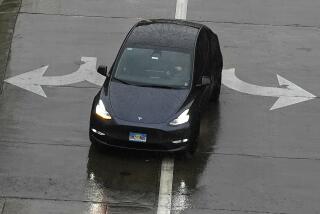U.S.-Built Cars Continue Sales Gains in April : Autos: But riot-torn L.A. is left out in the cold as dealers across the country celebrate what appears to be the end of a long slump.
DETROIT — The auto industry’s fledgling recovery gained slight momentum in April, as sales of U.S.-built cars for the last 10 days of the month climbed 10.8% above the weak year-earlier period, auto makers said Tuesday.
The pace of imported and domestic car and truck sales--still sluggish compared to pre-recession rates--edged up for the third straight month, persuading wary auto executives and dealers that despite several false starts over the last year, the most recent hints of strengthening sales are for real.
The sales report reflected the first solid evidence of the effect of price increases by Japanese auto makers on their products, as the Japanese share slipped to 23.9% of the U.S. market in April from last year’s level of 25.5%. Domestic auto producers posted a 2.4 percentage point gain in April, to 72.8%.
But as auto dealers across the country celebrate what appears to be the end of the long sales slump, Los Angeles dealers say their sales have ground to a halt since rioting erupted last Wednesday. If May is as bad a sales month in the Southland as many predict, the lost business could briefly set back the national auto recovery as well.
“It couldn’t have come at a worse time,” said Paul Wondries, co-owner of three franchises--Ford, Toyota and Nissan--in Alhambra. “Things were looking up. The month of April was dynamite. Then Thursday it just died.”
A temporary sales lull in most major cities would likely have little effect on auto production and industry profits. But Californians buy roughly 10% of the vehicles sold in the United States each year, with Los Angeles-area residents accounting for the lion’s share. So when sales plunge in Los Angeles, the ripples are felt on a national scale.
Michael Mahoney, who manages Toyota’s 70 dealerships in the Los Angeles region, said sales last weekend were off 30% from the previous weekend, with dealers reporting 500 fewer new car and truck sales than expected. His region accounts for 13% of Toyota’s U.S. new car sales and 16% of truck sales, Mahoney said.
“We might lose 5% to 10% over the total month. When you pro-rate it nationally, that’s only a 2% change. Still, it’s a lot of cars and a lot of money,” he said. “It won’t help the recovery, and it may delay it by a few weeks or up to a few months.”
Most industry analysts expect the national impact of the riot-induced sales slump to be negligible, in part because the thousands who lost their homes and jobs as a result were not prospective new car buyers in the first place.
“We’re talking small, small numbers here,” said Joel Pitcoff, a sales analyst at Ford Motor Co. “Where there may be some impact on business is in truck sales. If and when the reconstruction effort is launched, that should generate some demand for pickups.”
But for dealers who have been forced to close or curtail advertising over the last week, the ramifications are more significant.
“It’s going to be another couple of weeks at least before things get better,” said Elmer Fagen, general manager of Crenshaw Motors, which sustained minor damage from a firebomb during last week’s violence. “Business is off better than 50%. People just aren’t going to come down here.”
After an April that was 20% better than March, Ji Suh, general manager of Korean-owned Vermont Chevrolet, estimated that the franchise has lost $100,000 in sales already this month. To protect the inventory, employees moved the cars into an underground parking garage last week and took down signs that said “Welcome Customers” in Korean.
“We didn’t want to offend anybody,” Suh said. “Now we have all the inventory out on the lot, the the National Guard is pulling out, and those cars out there are all brand new. It’s a terrible feeling.”
But as Los Angeles dealers scrambled to pick up the pieces, the recovery chugged along in the rest of the country.
On a seasonally adjusted basis, the sales results for April amounted to an annual rate of 12.6 million cars and trucks, one notch above March’s pace of 12.5 million vehicles, but a far cry from the pre-recession annual rate of 15 million to 16 million. The seasonally adjusted annual rate is a reflection of the number of vehicles that would be sold if April’s sales pace were to continue for a full year.
“As the economic recovery proceeds and consumer confidence continues to strengthen, we look forward to a pickup in new vehicle sales and a gradual return to more normal selling rates,” said J. B. Fitzpatrick, General Motors Corp. marketing vice president.
Auto Sales
Seasonally adjusted annual rates for cars and trucks sold in the United States. Domestic figures include vehicles built in the United States by Japanese auto makers. The figures use seasonal patterns to predict the auto industry’s sales rate for a full year.
In millions of vehicles
1991
APR: 11.2
MAY: 12.4
JUN: 12.9
JUL: 13.1
AUG: 12.6
SEP: 13.3
OCT: 12.0
NOV: 12.5
DEC: 13.2
1992
JAN: 11.8
FEB: 12.5
MAR: 12.5
APR: 12.6
Source: Commerce Department






